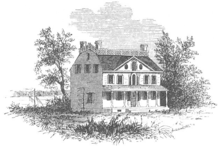Beekman Place
Beekman Place is a small street located in the Turtle Bay neighborhood on the East Side of Manhattan, New York City. Running from north to south for two blocks, the street is situated between the eastern end of 51st Street and Mitchell Place, where it ends at a retaining wall above 49th Street, overlooking the glass apartment towers at 860 and 870 United Nations Plaza, just north of the headquarters of the United Nations.[1] "Beekman Place" also refers to the residential neighborhood that surrounds the street itself. It is named after the Beekman family, who were influential in New York City's development.[2]
History

The neighborhood was the site of the Beekman family mansion, Mount Pleasant, which James Beekman built in 1765. James Beekman was a descendant of Willem Beekman, for whom Beekman Street and William Street were named. The British made their headquarters in the mansion for a time during the American Revolutionary War, and Nathan Hale was tried as a spy in the mansion's greenhouse and hanged in a nearby orchard. George Washington visited the house many times during his presidency. The Beekman family lived at Mount Pleasant until a cholera epidemic forced them to move in 1854, but the home survived until 1874, when it was torn down.
With the surge of immigration from Europe in the late 19th and early 20th century, the Lower East Side's slums expanded north. The Beekman Place area's well-off residents gave way to impoverished workers employed in the coalyards that lined much of the East River. The neighborhood's rehabilitation began in the 1920s, facilitated primarily by Anne Morgan of the Morgan banking family,[3] who lived slightly farther north on Sutton Place.
Notable buildings
One Beekman Place, the 1929 co-op designed by Sloan & Robertson and Corbett, Harrison & MacMurray, is "the most prestigious Beekman Place apartment building";[4] It was built by a group headed by David Milton, husband of Abby Rockefeller and son-in-law of John D. Rockefeller, Jr. Early tenants here included "Wild Bill" Donovan of the OSS and John D. Rockefeller III.[5] In the 1950s, 1 Beekman Place was the residence of Sir Francis Rundall, the British consul-general in New York.[6]
Modernist architect Paul Rudolph designed his four-level penthouse at the townhouse at 23 Beekman Place.[7]
29 Beekman Place, a seven-story, limestone-and-brick mansion house of 12,260 square feet (1,139 m2),[8] was built in 1934 for CBS chief executive William S. Paley for his first wife, Dorothy Paley.[9] Paley then rented the house to the health advocates Albert and Mary Lasker, who lived there for 35 years, until it was acquired by Princess Ashraf Pahlavi of Iran, the twin sister of Mohammad Reza Pahlavi, the last shah of Iran.[9][8] Ashraf Pahlavi lived in the home for many years; after her death in 2016, the home was the subject of legal proceedings.[8] Although initially listed for $49 million,[9] a real estate company finally sold the home in 2020, after several years on the market, for $11.5 million.[8]
31 Beekman Place was formerly owned by the Welsh singer Tom Jones; it was later purchased for the Pahlavis' attaché in New York. In 1981, after the Iranian Revolution, ownership was transferred to a Dutch Antilles entity to prevent the home from being seized by the new Iranian government. In 1992, 31 Beekman was sold to the government of Tunisia for use as a diplomatic property;[9] it is now the office of the Tunisian permanent mission to the United Nations.[10]
In popular culture
- In Irwin Shaw's The Eighty Yard Run, the main character lives here after blocking big Swedes and Poles.
- In Patrick Dennis's novel Auntie Mame (1955) and its various adaptations, the title character lives at 3 Beekman Place.
- In Sydney Pollack's movie The Way We Were (1973), Beekman Place symbolizes the WASPish cultural background of Hubbell Gardiner (Robert Redford's character) that is a continual irritant in his relationship with the Marxist Jew Katie Morosky (played by Barbra Streisand).
- In Tom Wolfe's novel The Bonfire of the Vanities (1987) and its movie adaptation (1990), the mayor says of Beekman Place: "They sit in their co-ops, Park Avenue, Fifth, Beekman Place, snug like a bug. Twelve-foot ceilings, a wing for them, one for the help."
- In Billy Joel's song "Close to the Borderline", the ninth track from the album Glass Houses (1980), he writes: "While the millionaires hide in Beekman Place, the bag ladies throw their bones in my face."
- In Netflix's Unbreakable Kimmy Schmidt, Kimmy becomes romantically interested in Logan Beekman, despite being unaware of the history of his esteemed family.
- In Alan Glynn's novel Receptor, political consultant Ray Sweeney visits retired CIA official Clay Proctor at his luxury apartment building in Beekman Place.
References
- Paul Goldberger, The City Observed: New York City—A Guide to the Architecture of Manhattan. New York: Vintage Books, 1979.
- Aitken, William Benford (1912). Distinguished Families In America: Descended From Wilhelmus Beekman And Jan Thomasse Van Dyke. The Knickerbocker Press. Retrieved August 22, 2009.
- Henry, Moscow (1990) [1979]. The Street Book: An Encyclopedia of Manhattan's Street Names and Their Origins. Fordham University Press. p. 27. ISBN 0-8232-1275-0.
- One Beekman, 1 Beekman Place: At The Southeast Corner Of Mitchell Place, City Realty (accessed September 4, 2020).
- Freitag, Michael (August 24, 1986). "If You're Thinking Of Living In; Beekman Place". The New York Times.
- Geoffrey T. Hellman (October 6, 1956). "Happy Man". New Yorker. p. 34.
- Look Alive! Paul Rudolph's Manhattan loft at 23 Beekman Place hits the market, The Architect's Newspaper (December 14, 2012).
- Vivian Marino, The Manhattan Home of an Iranian Princess Finally Sells, New York Times (September 4, 2020).
- Matt A.V. Chaban, In Era of Iconoclasts, Imagination Took Wing on Beekman Place, New York Times (September 9, 2014).
- Republic of Tunisia, Ministry of Foreign Affairs, Permanent Mission of Tunisia to the United Nations in NEW YORK, United States.